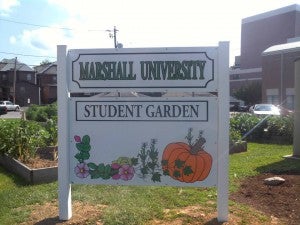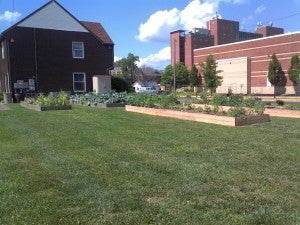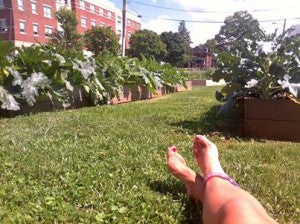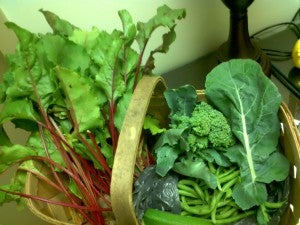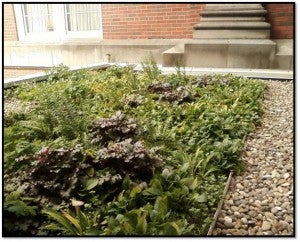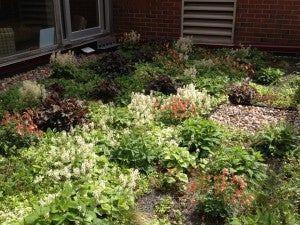The Sustainability Department at Marshall University is dedicated to being environmentally conscious in every area it can affect. The department promotes conservation of water and energy, campus wide recycling, and they look for ways to incorporate green technologies and materials into the University. In 2011, in an effort to create productive “Green Spaces” on campus, the first sustainability garden was installed: the Student Garden. Since then, our garden spaces have continued to expand each year.
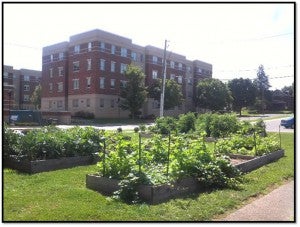 The Marshall University Student Garden came about due to a vision by Steve Hensley, Dean of Student Affairs. He wished for an area on campus where students could go to plant a vegetable garden, kick back, relax, and learn. The goal was to connect them with their food sources with hands-on experiences.
The Marshall University Student Garden came about due to a vision by Steve Hensley, Dean of Student Affairs. He wished for an area on campus where students could go to plant a vegetable garden, kick back, relax, and learn. The goal was to connect them with their food sources with hands-on experiences.
The Student Garden is located directly behind the Career Services building, 1687 5th Avenue. [See it on Google Street View]
During the second year, Marshall University Instructor, Rick Abel, and his Parks and Recreation Organization of Students (PROS), took over the raised beds. The group does a fantastic job in maintaining the plants. The plants come from donations or by starting seedlings in the Marshall Greenhouse.
Produce from this garden serves university students, low-income residents, and the Huntington Area Food Bank.
Student volunteers are welcome! Just email: bemarshallgreen@marshall.edu
Rain Garden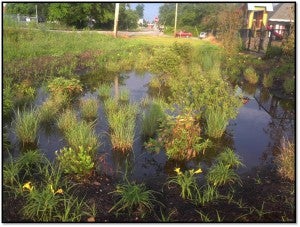 This garden is also under the supervision of Travis Bailey. The purpose of this garden is storm water management and filtration of that water. Rain gardens take a load off the storm water systems that can sometimes overflow and create flooding issues. They also act as a water filtration system, which is needed to clean the runoff water from streets and drive ways that could contain oil and other chemicals.
This garden is also under the supervision of Travis Bailey. The purpose of this garden is storm water management and filtration of that water. Rain gardens take a load off the storm water systems that can sometimes overflow and create flooding issues. They also act as a water filtration system, which is needed to clean the runoff water from streets and drive ways that could contain oil and other chemicals.
This garden is located off 5th Street behind the Marshall University Child Development Academy. It was built in the spring semester of 2013. [See it on Google Street View]
Green Roof on the Science Building
This garden was 2 years in the making. It was installed September 3, 2013, on a small roof adjacent to the science building. The green roof was the vision of Chuck Somerville, Dean of the College of Science. He wanted to experiment with the benefits of a roof-top garden. A green roof, if put in correctly, can extend the life of a roof for more than 20 or 40 years. It can also control warm and cool temperatures within the building while providing a much-needed habitat for local and visiting wildlife, such as butterflies and birds.
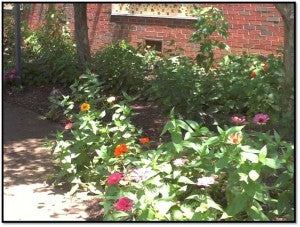 This garden started in the spring semester of 2013. The idea for this project came about as a joint effort between Chuck Somerville, Dean of the College of Science, and Travis Bailey, Marshall’s environmental and safety office. Rick Abel, assistant professor of NRRM, assigned the growing and care of the plants to Angela Kargul, senior in NRRM.
This garden started in the spring semester of 2013. The idea for this project came about as a joint effort between Chuck Somerville, Dean of the College of Science, and Travis Bailey, Marshall’s environmental and safety office. Rick Abel, assistant professor of NRRM, assigned the growing and care of the plants to Angela Kargul, senior in NRRM.
All of the plants for this garden came from the non-profit organization Monarch Watch. They put together a Monarch Waystation Seed Kit; the kit comes with a mix of 8 different plants to support every stage of the butterfly’s life. These plants were grown in the greenhouse which is attached to the Science Building and when they matured; members of the PROS group came together and planted them in the butterfly garden. This garden is located at the northwest corner of Buskirk Hall.
VIP Garden and Butterfly Oasis
Our pollinator garden contains plants that are native to our region which thrive in our climates and soils that help preserve and provide habitat for native bees, moths, birds, butterflies, flies, beetles and other pollinators.
 Major threats to pollinators include habitat loss, degradation, non-native species, pollution, pesticides, disease and climate change. Without pollinators most flowering plants could not reproduce. One third of our food crops depend on the services of pollinators.
Major threats to pollinators include habitat loss, degradation, non-native species, pollution, pesticides, disease and climate change. Without pollinators most flowering plants could not reproduce. One third of our food crops depend on the services of pollinators.
The VIP (Very Important Pollinator) and Butterfly Oasis Gardens were installed by the Marshall University Sustainability Department in the spring of 2014. The Butterfly Oasis Garden was expanded in 2015.
A special thank you to Guyan Conservation District for their contribution of seeds to this garden.
